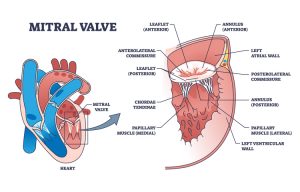
Background
The mitral valve controls blood flow between the atrium and the ventricle on the left side of the heart, which pumps oxygenated blood to the body. There are two main problems that can occur with the mitral valve: it can become too narrow (stenosis), or it can leak (regurgitation). Abnormal blood flow through this valve causes the heart to work harder and eventually can lead to heart failure. Symptoms of this include shortness of breath, light-headedness, fatigue, chest pain or palpitations.
Mitral stenosis is almost always caused by rheumatic heart disease, while mitral regurgitation is much more common and usually happens due to gradual degeneration of the leaflets and cords that hold the valve together.
About the surgery
Depending on the type of mitral valve disease, the valve can either be repaired or replaced with an artificial prosthesis.
Repair is preferred over replacement for many patients as it provides good long-term durability without the need for use of blood-thinning medication (anticoagulants). It may also offer better long-term survival, better preservation of heart function, and lower risk of complications. Repair can be performed in a large proportion of patients with mitral regurgitation, and in selected patients with mitral stenosis. There are many ways of repairing the mitral valve, including removal or replacement of damaged parts of the valve, and most patients will have the repair reinforced with an artificial ring or band around the outside of the valve.
If the mitral valve does need to be replaced, this may be done with either a porcine or bovine pericardial valve (tissue valve) or a mechanical valve (see “Which valve is right for me?“).

